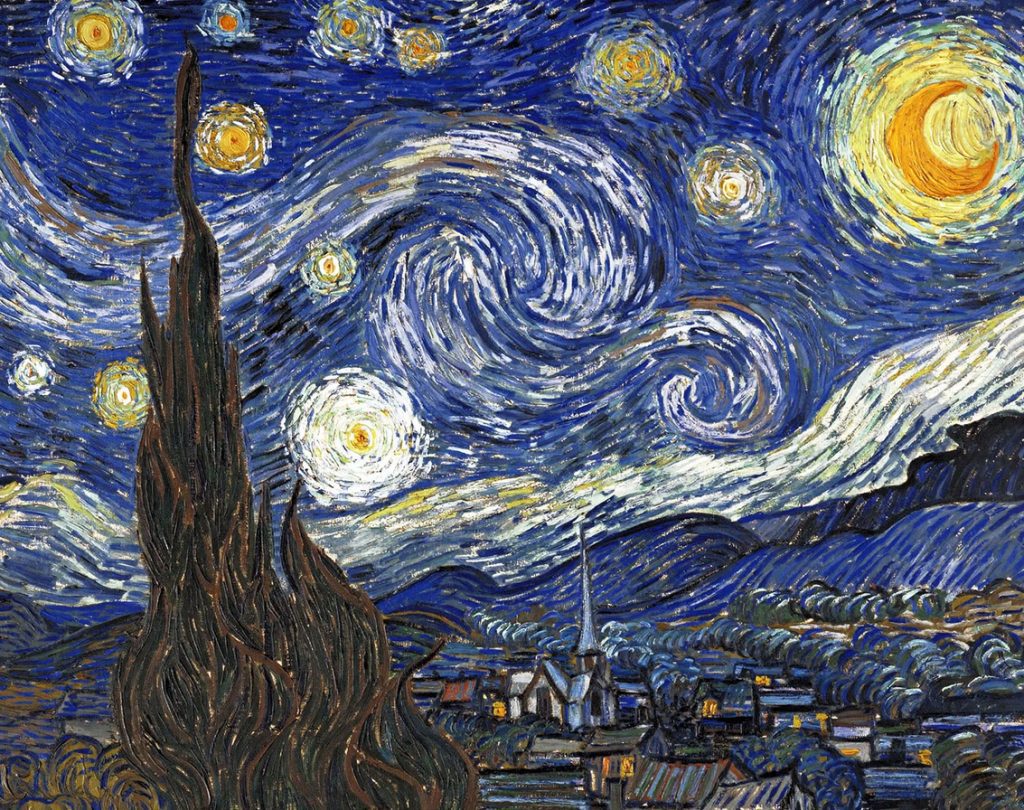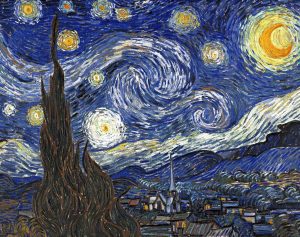Vincent Van Gogh, one of the most iconic painters of all time, was often referred to as “the Red-headed Madman” as people feared his behavior. Despite deteriorating mental health and financial instability, Van Gogh was a true artistic genius.
Vincent Van Gogh’s art career lasted only ten years, but it was prolific. He created as many as 900 paintings during his lifetime. Among these is Starry Night, not only Vincent Van Gogh’s most iconic painting but also one of the best-known paintings of all time.
This article will discuss Starry Night, its creation, and why it became one of his best works. So if you are a fan of Van Gogh and want to know more about Starry Night, this article is for you. Read on!
About Starry Night
Created in June 1889, Starry Night is a timeless and magnificent painting by the famous Dutch artist Vincent Van Gogh. In a moderately abstract landscape painting, Van Gogh portrayed an expressive night sky over a small hillside village. The painting is a dreamy interpretation of the night sky as seen from his room in the Saint-Paul asylum in Saint-Rémy-de-Provence, France.
The most famous Vincent van Gogh artwork evokes the serenity and tranquillity of rural life by focusing on a small section of a large landscape. With nature’s wave-like patterns winding across the foreground and background, he creates a scene of movement mainly using complementary colors.
Today, Starry Night is one of the most recognized paintings and can be found gracing the walls of museums, and art galleries, printed on mugs, t-shirts, and even on walls of Facebook and Instagram profiles. Back then, Van Gogh was not happy with the piece—he even believed the painting was among his failed creations during his years in the asylum.
Created in the Asylum
Starry Night is revered by art lovers around the world. As mentioned, it was painted in an asylum outside Saint-Rémy in the south of France. He was initially supposed to be sent to a large public asylum in Marseille but was admitted instead to the asylum in Saint-Remy, where he spent the following year.
If the artist had been admitted to the larger asylum, we would probably not have seen this particular masterpiece by the artist. The Saint-Paul asylum had only 41 patients, which allowed Van Gogh to be treated with kindness and understanding.
Doctors at the Saint-Rémy quickly understood that the only way to save Van Gogh was to give him his freedom and space to create paintings. During his time in the asylum, Van Gogh was much more creative, and his work ethic was stronger than ever. While other patients in the asylum spent their nights screaming, Vincent would stay up the entire night creating works of art, mostly optimistic landscapes.
Van Gogh showed great consistency in painting while he was in the asylum. The artist finished over 150 paintings during his stay in the asylum, equating to about one painting daily. On June 18, 1889, he completed Starry Night, which today is a globally loved art phenomenon.
The Road to Starry Night
Vincent Van Gogh was a self-taught artist who did not even touch a paintbrush until he was 27. Ten years later, he was dead. In the last four years of his career, the Dutch master discovered and perfected the post-impressionist style that we know him for.
Vincent observed art from around the world to discover his unique style, which laid the foundation of Starry Night. From Monet and Pissarro to younger generation artists, including Paul Signac and Émile Bernard, Van Gogh was exposed to all types of artists and their styles.
The composition of Starry Night also shares a resemblance to the woodblock print The Great Wave Off Kanagawa by the Japanese artist Katsushika Hokusai. The swirling composition and rich blue tones can be seen in both paintings.
In a letter to his brother Theo, Van Gogh described how he loved the countryside view from his window at the asylum, with nothing but the morning star. He was deeply enchanted by this view and planned to portray it on canvas very soon. That is how Starry Night came to be.
Why is Starry Night So Popular?
One of the main reasons Starry Night has become so popular among critics and audiences is its swirling composition of the sky and melancholic blue palette. Composed of celestial swirls, stylized stars, and a radiating crescent moon, the painting is one of the most recognizable in art history.
That’s not all. The painting features short brushstrokes with an artificial color palette and a focus on luminescence. It is this same treatment by the artist that makes the painting one of the greatest and most famous ever.
The Bottom Line
To sum up, Vincent Van Gogh’s Starry Night is one of the most impressive paintings in world art. It has been owned by various individuals over the years and has been at the Museum of Modern Art in New York since 1941.
From several museums to art replicas sold at art galleries to t-shirts and coffee mugs, Starry Night is everywhere.
Resources to Recover and Our Sponsor Laurel House Celebrate Black History Month
February is Black History Month, a time for celebrating the outstanding achievements of Blacks and African Americans and their central role in US history. It is also a time to recognize the struggles Black people have faced throughout our nation's history and give tribute to the strength and resilience of generations of Black Americans who have risen above adversity.
Black History Month originated from an idea by Harvard-educated historian Carter G. Woodson, who wrote the Journal of Negro History in 1916 to herald the achievements of overlooked African Americans in US history and culture. In 1926 he led an effort by the Association for the Study of Afro-American Life and History (ASALH) to officially declare the second week of February as "Negro History Week." These dates align with the birthdays of two crucial figures in Black American history: Abraham Lincoln (February 12, 1809), who signed the Emancipation Proclamation officially ending slavery in the United States, and the Black American abolitionist and author Frederick Douglass (February 14, 1818), who escaped from slavery to become one of the most influential civil and human rights advocates of the 19th century. In 1976, President Gerald Ford gave official governmental recognition to the observance by declaring February "Black History Month."
Without the contributions of Blacks and African Americans to more than 500 years of US history, culture, entertainment and the arts, science, athletics, industry and the economy, public service, and the Armed Forces, we would not be the country we are today.
The opinions and views expressed in any guest blog post do not necessarily reflect those of www.rtor.org or its sponsor, Laurel House, Inc. The author and www.rtor.org have no affiliations with any products or services mentioned in the article or linked to therein. Guest Authors may have affiliations to products mentioned or linked to in their author bios.
Recommended for You
- Why Eating Disorders in Men Are Often Missed - July 3, 2025
- No More Silence: The Opioid Epidemic’s Alarming Impact on Women - June 30, 2025
- The Hidden Impact of Repressed Memories on Mental Health and How to Heal - June 26, 2025





